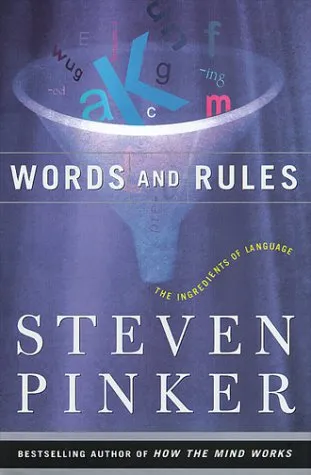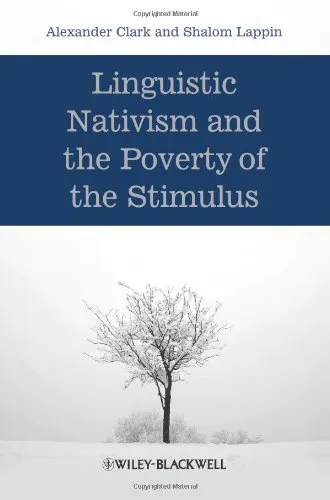Words and rules : the ingredients of language
4.5
بر اساس نظر کاربران

شما میتونید سوالاتتون در باره کتاب رو از هوش مصنوعیش بعد از ورود بپرسید
هر دانلود یا پرسش از هوش مصنوعی 2 امتیاز لازم دارد، برای بدست آوردن امتیاز رایگان، به صفحه ی راهنمای امتیازات سر بزنید و یک سری کار ارزشمند انجام بدینکتاب های مرتبط:
معرفی کتاب «Words and Rules: The Ingredients of Language»
کتاب «Words and Rules: The Ingredients of Language» نوشته استیون پینکر (Steven Pinker) یکی از آثار برجسته در حوزه زبانشناسی و روانشناسی زبان است. این کتاب به شکلی جذاب و علمی به بررسی ساختار زبان و فرایندهای فکری مرتبط با آن میپردازد. پینکر با تکیه بر اصول شناختشناسی و تحقیقات عمیق خود، نشان میدهد که چگونه زبان انسان حاصل ترکیبی از قواعد (Rules) و واژگان (Words) است.
خلاصهای جامع از کتاب
پینکر در این کتاب به بررسی دو عنصر اساسی در زبان انسان یعنی بین واژگان و قواعد زبان میپردازد. او نشان میدهد که این دو عنصر چگونه با یکدیگر تعامل میکنند تا زبان را به چیزی فراتر از یک سیستم صرفاً فهرستوار تبدیل کنند. پینکر بهطور ویژه موضوعاتی مانند ساختار صرفی، قواعد دستوری، و نحوه شکلگیری افعال بیقاعده را مورد تحلیل قرار میدهد.
یکی از موضوعات جذاب مطرحشده در کتاب، تفاوت بین افعال قاعدهمند و بیقاعده در زبان انگلیسی است. بهعنوان مثال، افعال قاعدهمند با اضافهکردن پسوند -ed به گذشته تبدیل میشوند؛ درحالیکه افعال بیقاعده روندهای خاص و متفاوتی را دنبال میکنند (مانند go که به went تبدیل میشود). پینکر از این بحث بهعنوان نمونهای برای توضیح ارتباط بین ذخیرهسازی حافظه و استفاده از قواعد عمومی بهره میبرد.
این کتاب همچنین به جنبههای زیستشناختی و شناختی زبان میپردازد و نقش مغز انسان در تولید و پردازش زبان را توضیح میدهد. پینکر از نظریههای Evolutionary psychology کمک میگیرد تا نشان دهد که چرا برخی از ویژگیهای زبان در طول زمان تکامل یافتهاند.
نکات کلیدی
- ترکیب واژگان و قواعد به شکلگیری زبان پیچیده کمک میکند.
- افعال بیقاعده بهطور خاص جنبههای حافظه و فرایندهای یادگیری انسانی را روشن میسازند.
- زبان نهتنها ابزاری برای ارتباط، بلکه یک ویژگی شناختی آمیخته با تکامل زیستی است.
- مطالعه زبان میتواند به شناخت سیستمهای مغزی پیشرفتهتر و نحوه ارتباط آنها با ادراک کمک کند.
جملات مشهور از کتاب
«Language is not just any skill, it is the most uniquely human talent.»
«Regularity in language is like the laws of physics applied to human thought.»
«The irregularities of language are as much a part of its nature as its regularity.»
چرا این کتاب مهم است؟
کتاب «Words and Rules» بهعنوان یک اثر میانرشتهای اهمیت بالایی در عرصه زبانشناسی، روانشناسی شناختی و علوم زیستی دارد. پینکر با زبانی ساده اما علمی، اصول پیچیده و علمی زبان را توضیح میدهد که برای طیف گستردهای از مخاطبان جذاب است. این کتاب نه تنها برای متخصصان زبانشناسی و علوم شناختی، بلکه برای افراد علاقهمند به فهم بهتر مغز و الگوهای فکری انسان نیز مفید است.
اهمیت این کتاب به این نکته بازمیگردد که بهجای درخواست از مخاطب برای پذیرش فرضیات پیچیده، او را با شواهد و مدلهای روشن قانع میکند. پینکر قابلیتهای زبان را از منظرهای مختلف بررسی میکند؛ خواه زیربنای زیستی، خواه تعامل اجتماعی یا نحوه یادگیری زبان در کودکان.
اگر به دنبال کتابی هستید که شما را با عمق و پیچیدگی زبان آشنا کند و همچنین درکی تازه از تواناییهای شناختی انسان ارائه دهد، «Words and Rules» انتخابی بینظیر است.
Introduction to Words and Rules: The Ingredients of Language
Language, one of humanity's most remarkable inventions, is beautifully complex, teeming with patterns that reflect the mechanics of thought and culture. In Words and Rules: The Ingredients of Language, Steven Pinker bridges the fields of linguistics, psychology, and cognitive science to explore how humans understand and produce language. Revolving around one of the central mysteries of human cognition—how language arises—this book unpacks the systematic interaction of words and grammatical rules in shaping our capacity to communicate.
Designed to be both accessible and intellectually invigorating, Pinker’s work delves deep into the dual nature of language: irregular verbs whose forms we memorize word-for-word, and regular verbs governed by predictable rules. The result is a gripping investigation of what these dual mechanisms reveal about language, memory, and the human mind itself.
Detailed Summary of the Book
At the heart of Words and Rules lies the question: How does the mind produce language? Pinker tackles this by examining the brain's handling of verbs, those workhorses of grammar. He explains how verbs fall into two categories—regular and irregular. Regular verbs follow a predictable past-tense rule, like "walk" becoming "walked." Irregular verbs, on the other hand, resist these tidy rules and instead rely on memory, like "go" becoming "went."
The book uses this distinction as a lens to understand broader principles. Pinker looks at how children learn language, revealing the early experiments of overgeneralization (e.g., saying "goed" instead of "went") that demonstrate their grasp of rules before they memorize irregular forms. Additionally, he examines neural studies showing how different parts of the brain are responsible for regular and irregular verb processing, hinting at a physical basis for the "words and rules" framework.
Beyond just verbs, Pinker extends the discussion to explore language evolution, neuroscientific discoveries in linguistics, and how these theories apply across multiple languages. Through detailed case studies and lively anecdotes, Words and Rules presents an elegant synthesis of empirical research, theoretical insights, and relatable examples.
Key Takeaways
- Language reflects the interplay between memory (words) and computation (rules).
- Children's language mistakes (like "comed" or "runned") are evidence of mental rule-building in action.
- Irregular verbs require exception-based memory, while regular verbs rely on built-in grammatical rules.
- The dual-system model offers insights not only into language but also into how the brain processes information.
- Understanding verbs and morphology can shed light on the evolution of human cognition and the uniqueness of our species.
Famous Quotes from the Book
- "Language is the most complex thing that humans do, but it comes so naturally to us that we rarely stop to think about it."
- "The exquisite interplay between words as memories and rules as computations offers a glimpse into the machinery of the human mind."
- "The child is not just learning a language but is unwittingly inventing one."
- "Irregulars are the fossils of language, carrying the imprints of its history, while regular patterns are its ever-evolving architecture."
- "Words and rules show us that the mind is neither a simple dictionary nor a rigid grammar book but something in between."
Why This Book Matters
Words and Rules: The Ingredients of Language matters because it connects everyday experiences—such as making grammatical mistakes or hearing a child's first words—with profound questions about the mind and brain. It's a testament to human curiosity about how we think, communicate, and learn. By examining the fundamental components of language, Pinker also contributes to fields as diverse as artificial intelligence, education, and cognitive neuroscience.
The book holds particular appeal for anyone fascinated by language in all its forms: linguists intrigued by morphology, psychologists interested in development, and lay readers seeking a deeper appreciation of how language shapes thought. It challenges us to see language not as an opaque ability but as a transparent window into human nature and cultural history.
Through its balance of storytelling, rigorous data, and elegant theory, Words and Rules enriches our understanding of what makes us uniquely human.
دانلود رایگان مستقیم
You Can Download this book after Login
دسترسی به کتابها از طریق پلتفرمهای قانونی و کتابخانههای عمومی نه تنها از حقوق نویسندگان و ناشران حمایت میکند، بلکه به پایداری فرهنگ کتابخوانی نیز کمک میرساند. پیش از دانلود، لحظهای به بررسی این گزینهها فکر کنید.
این کتاب رو در پلتفرم های دیگه ببینید
WorldCat به شما کمک میکنه تا کتاب ها رو در کتابخانه های سراسر دنیا پیدا کنید
امتیازها، نظرات تخصصی و صحبت ها درباره کتاب را در Goodreads ببینید
کتابهای کمیاب یا دست دوم را در AbeBooks پیدا کنید و بخرید



